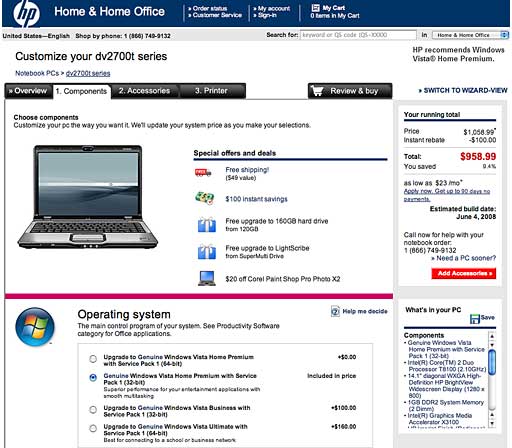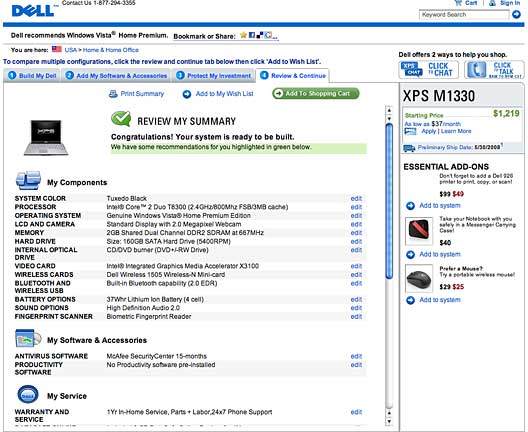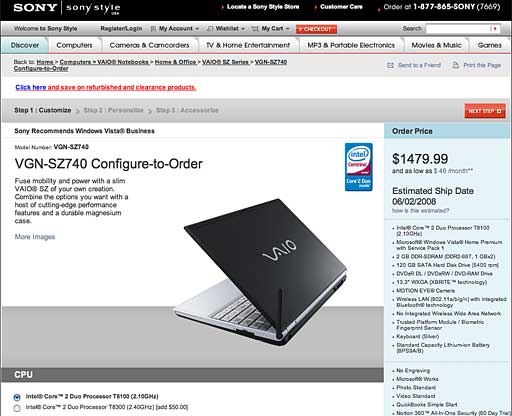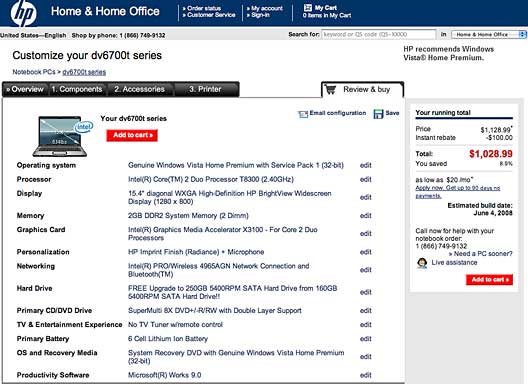In round two of my look at Macintosh pricing, we'll see how Apple
compares in the $1,000 to $1,500 price range for laptops. If you didn't
read the first article, Mac Pro Beats HP and Dell at
Their Own Game: Price, we are comparing Apple against HP and Dell
models with similar specifications. We agree that the other guys will
sell you something for much less - but you are also getting much
less.
When I started on this round of Mac versus PC price comparisons, I
thought my head was going to explode. I had to use duct tape wrapped
around my head to keep it in one piece so I could finish. The number of
seemingly meaningless choices was overwhelming.
Let's look at what we have to compare for laptop computers. This
time we'll pick on HP first; since HP swallowed Compaq, they seem to
have extra choices.
- Apple: MacBook, MacBook Air, MacBook Pro
- HP Compaq: 8510p, 8710p, 8510w, 9710w, 6720s, 6820s, 6515b,
6715b, 6510b, 6710b, 6910p, 2133 Mini-Note PC, 2510p, 2710p, C700T,
dv6700z, dv6700t,V6700TX, dv2700t, tx2000z, dv9700z, dv9700t, Pavilion
HDX Entertainment Notebook, plus two Special Edition models, and one
Artist Edition
Apple has three laptop choices while HP has 14 different business
models and 9 (more or less) different home models. Add all the possible
custom configurations, and it makes a small army of decisions a shopper
has to make. All that just to find your next laptop within one
company's website. Now multiply this for every brand you want to look
at.
On the positive side, this variety is great because it allows you to
pick the computer that is the perfect fit to your needs. On the
negative side, this is simply confusing - and besides, buying a
computer is not like buying wedding china. Computers are pretty darn
flexible, so getting a close fit would probably be great if you could
cut through all the complexity.
I'm starting to understand why IT departments stick with Dell and
HP: It is simply too much work to figure this mess out every time you
need to buy a new computer. By sticking with one brand, you cut your
choices down significantly - and then shop purely based on cost from
there.
The old IBM ThinkPad was great, because IT didn't have to think at
all about which computer to buy. They had one simple area for laptop
purchases. Too bad Lenovo screwed this up for them once they bought the
brand from IBM.
The Entry Level
While this job of comparison-shopping may sound easy, 13" displays
are standard for MacBooks, but there are none on HP's laptops. Most HP
laptops have 14" or 15" displays. Their ultralight computers come with
12" displays, but because they are ultralight models, they are more
expensive even though they use smaller displays. Since the budget HP
notebooks come with 14" displays, I will assume that 14" is fair for
comparison with 13.3" screen on the MacBook. There is simply no other
way to compare.
Another tricky difference is the whole home versus business thing
that is common at HP and Dell. Apple doesn't tell us that only
home users should buy a MacBook, while MacBook Pros are for businesses.
The difference is more about basic model versus deluxe model. MacBook
Pros are more expensive and have the full-featured specifications. If
you've got the money, buy whichever model fits your needs, whether you
are a home or business.
I did my best to match things up, but there just aren't perfect
comparisons. Still, except for a few details, I think the comparisons
are fairly close.
Editor's note: Prices were double-checked and screen
shots taken this morning, and we've done our best to be sure that
prices mentioned in this column match today's prices. Prices are very
much subject to change. dk
MacBook vs. HP dv2700t
Sorting through the choices, I found that HP offers the
dv2700t model with Core 2 Duo processors, just like the MacBook. The
dv2700t model starts at a very low price, $775 (after a $100 instant
rebate). It comes with the following: 1.83 GHz Core 2 Duo processor,
1 GB RAM, 160 GB hard drive, DVD burner, built-in webcam and
microphone, wireless 802.11g, and Intel Integrated Graphics X3100
graphics.
That is pretty close to the lowest MacBook, except that the
$1,099 MacBook has a 2.1 GHz processor, Bluetooth, and 802.11n
wireless.
- MacBook: 2.1 GHz Core 2 Duo processor, 1 GB RAM, 120 GB hard
drive, DVD reader, built-in webcam and microphone, Bluetooth, wireless
802.11n, and Intel Integrated Graphics X3100 graphics.
When I bumped the specifications up to closely match the base model
MacBook - using a 2.1 GHz CPU, adding 802.11n and Bluetooth, and
including a Windows Vista Home Premium recovery DVD - the final price
was $959. That beats the MacBook price by $140. Points go to HP for
having the better hardware specs and a cheaper price, but what about
software?

I will say that I got stumped on the software choices. Since I
haven't use Vista, and I won't call myself an expert on XP, it wasn't
obvious if you really need to buy the software listed for that model. A
Mac user is expecting iLife to handle many of the basic tasks. (I
called the customer support number listed on the web page, and a live
person was answering my questions quickly. They were friendly and
helpful. I will give HP a star rating for service.) The answer seems to
be "sort of" - there are things that get included, like PhotoSmart
Essentials and Muvee AutoProducer Basic. I'm going to guess that these
are not as well integrated as the whole iLife suite, but they'll get
you started.
I did think that it was tricky that the OS/Recovery DVD isn't
included with the purchase price; it has to be ordered separately for
$19. It is weird that HP doesn't automatically include it. It feels
like the airlines, how they are trying to raise profits by charging you
for anything extra.
There were some hardware advantages in HP's favor that couldn't be
adjusted. First is the slightly larger 14.1" display, although it
displays the same 1280 x 800 resolution as the MacBook. Second you get
a LightScribe DVD burner, while the low-end Mac has only a Combo drive
(CD burner/DVD reader). And third, HP gives a free upgrade to a 160 GB
hard drive. So for the hardware, HP is definitely the winner on price.
(I don't think I would trade my MacBook for one - not even with the
$140 difference. There are details that Apple includes that we aren't
going to cover.)
If you want to upgrade your software, there are a number of things
that would quickly use up the savings on hardware. Vista Business adds
$100 to the price, and Vista Ultimate adds $160. Norton Security is an
extra $39 for a 15-month subscription. (When buying a PC, you have to
remember that they do get viruses, so you have to protect your
computer.) Roxio PhotoSuite 9 adds another $69. The upgrade to Muvee
AutoProducer is another $99.
for the most part Mac OS X and iLife take care of all these minor
software choices. I'm going to say that on the included software side,
there may be advantages to the Mac. Of course, this will depend on you
and what software you may already own.
One other difference: The HP includes a 3 hour, 30 minute battery.
Add $39 for a 4 hour, 15 minute battery or $79 for a 7 hour battery.
The MacBook includes a 4 hour, 30 minute battery. Upgrading the HP to
the 4:15 battery reduces the price difference to $101.
MacBook vs. Dell XPS M1330
Let's jump over to the Dell website and see what they have that is
close. The
XPS M1330 is a really close match: it has a 13.3" screen like the
MacBook. The only problem is that Dell classifies it as a Ultralight at
4.0 lb. (It measures 12.5" wide x 9.4" deep x 0.97-1.43" height.) The
MacBook measures 12.8" wide x 8.9" deep x 1.08" height and weighs 5.0
lb.
We'll go ahead and use the XPS M1330 for our comparison, and points
go to Dell for making it lighter.
This first thing you notice when you customize is that Dell has a
"non-black tax" - you pay $25 extra for picking white, blue, or pink
instead of the standard black. This is funny for Mac users who remember
when people complained about Apple charging $200 more for the black
MacBook. Dell is doing the same thing - but in reverse.
At the lowest matching configuration, you get a 2.0 GHz Core 2 Duo
processor, 2 GB RAM, 160 GB hard drive, 8x DVD burner, Intel Integrated
Graphics X3100 graphics card, wireless-N, Bluetooth, a 4-cell battery
for $1,124 ($1,203 with a 6-cell battery to match the one in the
MacBook). Truthfully, the RAM and SuperDrive exceed the specifications
of the basic MacBook and are more comparable to the middle model, so
let's redo this comparison:
- MacBook, white - 2.4 GHz Core 2 Duo processor, 2 GB RAM, 160 GB hard
drive, 8x DVD burner, Intel Integrated Graphics X3100 graphics card,
802.11n wireless, and Bluetooth, $1,299
- XPS M1330, black - 2.4 GHz Core 2 Duo processor, 2 GB RAM, 160 GB
hard drive, DVD burner, Intel Integrated Graphics X3100 graphics card,
802.11n wireless, Bluetooth, and fingerprint reader, $1,219
The specifications are very close. Dell wins with the lowest price
by $80. That is not much of a win on price. Dell also has the lighter
laptop and a built-in fingerprint reader.

On the software side, you get McAfee Security Center for 15 months,
but no productivity software. Dell charges $130 more for Vista
Business, and $150 for Vista Ultimate. Again, for what it's worth, the
Apple wins on the software side of the purchase.
Wait just one second. Closer investigation reveals that Dell is
playing games on the "lightweight" design. Their weight specification
is based on using a cheap 4-cell, 37 Watt-hour battery. The MacBook
comes standard with a 6-cell, 55 Watt-hour battery. Dell is caught
marketing a "lightweight" design that they achieved by reducing the
battery weight and power. Laptops are all about mobility - who's going
to want a smaller battery? Worst of all, they charge an extra
$79 for the 6-cell upgrade. Now they cost just $21 less than Apple for
nearly identical specifications.
I'm going to call Apple the winner because of the better software
bundle and not offering a stripped version of Mac OS X - unless
you really can't live without a fingerprint reader.
Sony Style
We can throw in a quick comparison of a Sony VAIO®. Sony makes a
13.3" laptop,
VGN-SZ740. It has a starting price of $1,480 ($1,450 if you'd
rather have a black keyboard). At that price you get:
- VGN-SZ740 - 2.1 GHz Core 2 Duo processor, 2 GB RAM, 120 GB hard
drive, DVD burner, Intel Integrated Graphics X3100 graphics card,
wireless-N, Bluetooth, and a fingerprint reader.
At that price and with those specifications, the $1,299 2.4 GHz
MacBook is clearly in the lead. The standard 4 hour battery may be
underpowered too. Replacing it with a 5.5 hour battery adds $100 to the
price. And bumping CPU speed to 2.4 GHz to match Apple adds another $50
to this VAIO's price.

We'd better stick with the low-end brands like Dell and HP for this
comparison. Sony doesn't beat their prices or Apple's.
The High End
MacBook Pro vs. HP dv6700t
Let's do one final comparison, this time between a HP's
dv6700t (the same as the HP model above, but with a 15.4" display)
and a 15.4"
MacBook Pro.
- Dv6700t - 2.4 GHz Core 2 Duo processor, 2 GB RAM, 250 GB hard drive,
LightScribe DVD burner, Nvidia Geforce 8400M GT graphics with 256 MB,
1280 x 800 display, wireless 802.11n, Bluetooth, high capacity 6-cell
battery, Vista Business, and restore DVD, $1,029 (after $100 instant
rebate)
- MacBook Pro - 2.4 GHz Core 2 Duo processor, 2 GB RAM, 250 GB hard
drive, 8x DVD burner, Nvidia Geforce 8600M GT graphics with 256 MB,
1400 x 900 display, wireless 802.11n, and Bluetooth, $1,999

While not a perfect match up, these two machines have close
specifications. This time the Apple laptop is over than $900 more
expensive. That can't be explained by the slight difference in the
graphic card and display resolution. These two things are worth a few
hundred dollars at best. The high capacity battery (3 hours, 30
minutes) for the HP adds an extra $39. Even adding in these items, the
MacBook Pro doesn't come close to competing on price with this HP
model.
Why So Much More?
The MacBook Pro is a premium priced computer, but why? What's so
special, if the components inside are close to those offered by HP?
Most notebook PCs are made from nice looking but cheap to
manufacture plastic. The MacBook Pro has a metal construction to give
it a more solid feel. The MacBook Pro has many of these differences
that are seamlessly integrated into the design so they don't look like
tacked on extras (like the high capacity batteries for some PC
notebooks, for instance).
for example:
- Apple's keyboard is lit from below, so it's easy to use in a dark
area like a bedroom or coffee shop.
- There are ambient light sensors that control the brightness of the
MacBook pro keyboard automatically.
- Apple's trackpad uses multitouch sensing to control scrolling,
resizing, etc. - just like the iPhone. (The non-pro MacBook has
two-finger scrolling, and I think it is a killer feature that makes
using a trackpad much easier.)
- The MacBook Pro models are thinner (1" vs. 1.7" at the thickest
point) and slightly lighter than the HP.
- The display uses LED backlighting, which is supposed to reduce
power consumption, very important to laptops.
- The 15.4" MacBook Pro has a 1440 x 900 display; most 15.4" notebook
PCs have 1280 x 800 displays. You often need to buy a larger, heavier
17" notebook to match Apple's resolution.
- The MagSafe power connector is on all Mac laptops but doesn't exist
for any PCs.
- There are built-in motion sensors. They can tell if you drop your
computer and quickly park the read/write heads in the hard drives,
moving them to a safe position. (The sensors can be hacked to use for
input to a custom program; some games and a seismology program have
already been written for them.)
- You get both FireWire 400 and 800 ports, which can be useful.
That is a major collection of special features to set this model
apart from the crowd, but are these things worth the extra cost?
Are these things worth the extra cost? That is personal preference
and a matter of how much cash you are ready to spend. Apple, unlike HP
and Dell, doesn't configure its low-cost MacBook models to compete with
the higher-end MacBook Pro models. If you want premium performance, the
only way to get it is to go all the way.
One strange limitation is the lack of a Blu-ray option. While the
MacBook Pro comes standard with a dual-layer DVD burner, there is no
option for Blu-ray (HP charges $200 extra for it). Will you need this?
Maybe, and that's why it would make a reasonable option. Apple appears
to be behind the competition without this option, and Apple isn't
making excuses or promising to add it anytime soon. If you need one,
you'll have to buy a PC. (Insert your own speculation about when Apple
will add a Blu-ray option.)
66% Mac Market Share
It recently
came to light that for all computers over $1,000 sold through
retail stores, Apple has the lion's share of the market - 66% both
laptops and desktop combined. The article goes on to praise the Apple
retail store as the reason these sales are so high. While the Apple
retail store is an excellent place to shop, we simply cannot ignore the
aggressive pricing Apple has taken for its computers to compete with a
new PC in this price range.
for this round of comparisons, Apple has competitive offerings. We
see that on the base model MacBook, Apple did pretty well on price
against HP. HP was able save you a few dollars and throw in some nice
extras if you'd rather go the Vista route. for the midrange MacBook,
Apple held it's own against the Dell XPS M1330 and trounced the Sony
VAIO VGN-SZ740. On the pro level, Apple is much more expensive but
delivers unique features that are unmatched on a PC.
If you want a cheap computer, buy a PC, but don't complain when it's
slow playing a video game or Vista Aero isn't working. If you're
budgeting around $1,000, make sure you stop by an Apple Store and see
what they've got to offer. At the very least you'll be able to look at
all the Mac notebooks in less time in Apple's retail store than if you
went to the HP website (which I just suffered through).
One last thing I wanted to point out: Software requirements change
so fast that the budget computer just doesn't hold up well. for all the
computers that I've bought, both new and used, I've never later wished
I'd gotten the lower-end model instead. 






